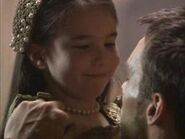"I swear to you now on the Holy Gospels and on the soul of my mother that I will make England faithful again. I will do whatever is takes. I will burn as many heretics, spill as much blood as it takes to make this unfortunate realm Catholic again, so help me God." — Princess Mary Tudor to Eustace Chapuys
Princess Mary Tudor is the only surviving child of Henry VIII and Catherine of Aragon, as well as the oldest of the King's children; notably, she is the only female character apart from Catherine Brooke to appear in all four seasons, although she played by a different actress during Season One, in which her role is only a brief one. The Irish actress Sarah Bolger plays her in an award-winning role. She appears as a recurring character in Seasons 2, 3 and 4 of The Tudors, spanning some 23 episodes.
Mary's personality changes overtime, mainly due to her father's various marriages (which dramatically affect her social rank, despite being the legitimate daughter of a King) and her own devoutly Catholic beliefs; she goes from being a cheerful, carefree little girl to a bitter, formidable young woman. Had her mother Catherine (with whom Mary had a very loving relationship) lived longer, Mary might have developed a more merciful disposition, but Catherine died while Mary was still a teenager. Mary had either hostile or at least mistrustful relationships with all her subsequent stepmothers except Jane Seymour, who died after only a year and a half of marriage to Henry. Although Mary initially loved her half-siblings Elizabeth and Edward, she was much older than either of them and became concerned about their exposure to Protestantism, believing that it would bring about England's doom.
As Henry is often absent or ineffective as a parent (despite Mary's continued love for him and vice versa), she finds a devoted friend and father-figure in the Imperial Ambassador, Eustace Chapuys. She maintains the royal title of Princess Mary until being demoted to simply Lady Mary, although she is later restored to the Royal Line. She would eventually become Mary I, becoming the first recognized Queen Regnant of England; however, today her short reign is remembered unfavorably, mainly due to her oppressive religious policies.
Season One
Mary appears in a few episodes early in Season 1 as a little girl. A descendant of the Royal houses of Tudor (England) and Castille-Aragon (Spain) she is introduced as the young daughter on whom Henry and Catherine shower affection. She is initially supposed to be married to the Dauphin of France, who is about the same age (whom she kisses and then knocks over when they first meet, to Henry's amusement), but when personal tensions develop between her father and King Francis at a summit, she is instead betrothed to King Charles V of Spain (also the Holy Roman Emperor), her mother's nephew who is more than a decade older than her. The marriage is deliberately put off by both parties because Mary is far too young, with the stipulation that the wedding will commence after Mary's 12th birthday. However, a combination of events causes Charles to breach the pact, despite his affection for Henry as he is married to Catherine (Charles' aunt). Charles manages to capture the King of France in a battle, but decides it is a good political move to release him, angering Henry. Charles is also mildly uneasy about a cousin marriage. The final nail in the coffin that ruins the arranged marriage is when Charles courts (and ultimately marries) a Portuguese princess, citing that she was closer to age to him than Mary and that he could not wait any longer to have a woman.
As a child Mary has a sweet, innocent personality that shows her later generosity; everyone who meets her (including Anne Boleyn, briefly) treats her with kindness.
However, Mary is increasingly separated from her mother thanks to the machinations of Catherine's enemy Cardinal Wolsey; her position as heir is also threatened by Henry's bastard son Henry Fitzroy, but the little boy soon dies during a sweating sickness outbreak. Despite the initially happy marriage between Mary's parents and the love they each have for her, Henry longs for a son, worrying Mary will not be seen as a proper heir despite being his legitimate child. Catherine's failure to produce a living son causes Henry to subsequently destroy the marriage. Mary is largely oblivious to the political machinations that revolve around her family, but by episode 1.05, when she is sent to live separately from her mother, she begins to realize something is wrong. Henry continues to recognize Mary as his daughter despite attempting to annul his marriage to Catherine, arranging a tentative betrothal between her and the Duke of Orleans (King Francis' second son) in episode 1.06, to solidify his new alliance with France. Despite having broken his marriage pact with her, Emperor Charles continues to show concern for her and her mother's well-being.
Season Two
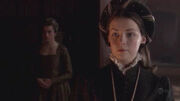
Mary arrives at Hatfield, Elizabeth's home
Upon her father's new marriage to Anne Boleyn in Season Two, Mary—now in her teens—is seen as a bastard due to the annulment of her mother's marriage, making way for Elizabeth Tudor to become the future heir. After openly refusing to recognize anyone except Catherine as the Queen in episode 2.03 (her first appearance since Season One), she loses virtually all her status (though retaining her property of Ludlow Castle in the Welsh Marches) and is permanently separated from her mother at Anne's urging, becoming a lady-in-waiting to her infant half-sister Elizabeth in 2.04. Mary endures this new position with surprising dignity (though her health suffers a few times) but she remains bitter, and Queen Anne's one attempt to make peace with her is insultingly rebuffed, causing Anne to grow paranoid and hostile towards her. Henry refuses to acknowledge Mary, yet he clearly still cares about her—he sends the royal physician to care for her when she is ill, and when departing after a visit to the baby Elizabeth, he sees Mary watching him and bows to her (something a King does not normally do, but likely showing he has some belief in their relationship as father and daughter).
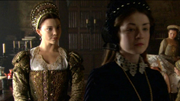
Mary rejects a peace offer from Queen Anne Boleyn (left)
Catherine dies in episode 2.07 after four years of separation from her daughter, much to Mary's grief; she receives a box containing some of Catherine's personal items, including jewelry from the royal house of Spain, Catherine's home country. Mary's hatred of Anne Boleyn is shared by the Imperial Court and the Papacy (though not by the French) but neither are able to help her directly. In particular, the Savoyard Imperial Ambassador Chapuys is extremely sympathetic to both her and her mother, and attempted to carry messages for them on many occasions. Regardless of his feelings and dealings concerning her father, the King (towards whom he has a rather low opinion in private), Chapuys remains a devoted friend and confidant to Mary in Seasons 2, 3 and 4. Towards the end of the season, both the French and the Spanish attempt to make deals with Henry that hinge on betrothals involving Mary, indicating they still view her as the legitimate heir over Elizabeth; however, although he hesitates, Henry still refuses to make her legitimate again, angry that France and Spain will not accept his annulment and remarriage. Despite this setback, Mary is visibly triumphant when Chapuys visits her in the season two finale: her nemesis Anne Boleyn has been accused of adultery and treason, and is now sentenced to death. With Henry's marriage to Anne annulled, Mary's half-sister Elizabeth is now just as 'illegitimate' as she is.
Season Three
At the start of Season Three, Mary hopes for reconciliation with her father thanks to the influence of his new wife Jane Seymour, who like her is a Catholic. However, she is first ordered by Sir Francis Bryan to sign an oath acknowledging Henry as Head of the Church, something she has long avoided due to her strong Catholic beliefs. Mary initially refuses to do this despite Bryan's threats, and asks Chapuys to request the support of her cousin Emperor Charles V, but Chapuys, despite sharing her Catholic convictions, informs her the Emperor can't help her because he's seeking a new alliance with England. Under the influence of Thomas Cromwell and other ruthless reformists, her father might be convinced to put her to death, so out of fear and despair she signs the document, asking Chapuys to help her secretly acquire Papal absolution. Jane Seymour makes it clear she wants Mary restored to favor and that she favored Mary's mother Catherine as Queen, and at the end of the episode Henry and Jane welcome her back to court; Mary is not restored to the Succession, but she is reconciled with her father and quickly becomes friends with Jane.
Inspired by Jane's generosity, Mary helps reconcile her little sister Elizabeth with Henry in 3.03. Despite Elizabeth being the daughter of her former enemy Anne Boleyn, this reconciliation works in Mary's favor as Henry is joyful to be reunited with his younger daughter akin to "daddy's little girl". However, in the next episode she, Henry and Elizabeth are saddened when Jane dies after giving birth to Henry's son Edward. While loyal to her father, Mary privately shows sympathy for the persecuted Catholic rebels during the Pilgrimage of Grace, as shown by her secret meeting with Robert Aske; when the movement is brutally crushed and Aske is hanged, she and Chapuys express sadness over his fate in episode 3.04. In 3.05, after Jane's demise, Mary tells Lady Margaret Bryan (the former governess of Elizabeth and Edward's new caregiver) that she intends to return to her country estates and spend some time with Elizabeth, as she, Henry and Edward are Mary's only surviving family in England.

Mary dances with Duke Philip of Bavaria, with whom she fell in love despite his Protestantism
In episode 3.08, Mary falls deeply in love with Duke Philip of Bavaria (whom she is introduced to by his cousin, Queen Anne of Cleves), and is left devastated when he is sent away by her father despite claiming she would not have considered marrying him due to his Lutheranism. In Seasons 3, with her return to court, Mary is shown to be beloved by the people, especially the Catholic sects that are persecuted by her father and Cromwell. In particular, she blames Cromwell for the executions of her former governess Margaret Pole and her family (though in fact the two people most responsible for these executions were Edward Seymour and Henry himself). Angered that Cromwell arranged for Henry to marry a Protestant princess, Mary views him as an agent of the Devil (due to his support of the Reformation) and remarks on more than one occasion that she would like to see him burned for heresy. Unsurprisingly, therefore, she shows satisfaction when he is executed in the season finale "The Undoing of Cromwell".
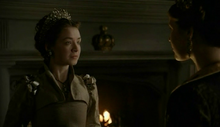
Mary is dismayed to learn that Philip has been sent back to Bavaria
Season Four

Mary is cheered by the North (Season 4)
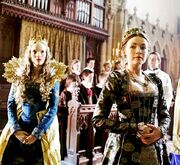
Mary and her new archnemesis, Queen Katherine Howard (left)
In the fourth and final season of the series, Mary's father remarries twice. Despite hating her father's fifth wife, Katherine Howard, Mary becomes rather close to his sixth and final wife Catherine Parr, although she confides to Chapuys that she knows Catherine is a Protestant (and therefore, in her eyes, a heretic). In episode 4.06 after Katherine Howard has been executed, Mary delightedly tells her sister Elizabeth that they have both been restored to the Succession after their brother Edward, a demonstration of their father's love. However, Elizabeth does not share her enthusiasm, and informs her that she has taken a vow never to marry, which confuses Mary.
During this season, with the feud between the Lutheran and Catholic factions of Court at its peak, Mary begins to show some of the ruthless fundamentalism towards her faith that would later characterize her reign, saying that if she ever became queen, she would spill as much blood as necessary to heal the country and restore its true Catholic faith. This fundamentalism eventually gets the better of her friendship with Catherine Parr when she privately supports an investigation that could have resulted in Catherine being tried and executed for heresy, even though Catherine was never anything but kind to her.
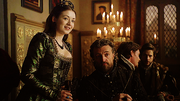
Mary in Season Four with her loyal friend, Ambassador Eustace Chapuys
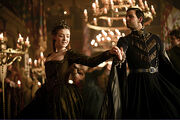
Mary dances with a Spanish military officer
Although Mary loyally views her younger brother as the true heir, Ambassador Chapuys and later Bishop Gardiner confide in her that many view her as a more official heir to the throne, since Edward's mother Jane Seymour was never officially crowned Queen of England; they also clearly hope she will restore Catholicism to England. In Season 4, Episode 8, she is sad to see Chapuys (who is by now greatly weakened by gout in his old age) retire and return to Spain, though they part as good friends; in the next episode she is informed that he has died. With Chapuys' more moderate influence gone, she is instead further exposed to Bishop Stephen Gardiner, a ruthless Catholic whose fanaticism equals hers. When her father (who is nearing his death) bids his family a loving farewell in the series finale, despite her differences with Catherine Parr, Mary holds Catherine's hand and weeps with her; she notices that her sister Elizabeth does not join them in crying, but calmly leaves. Henry also sees Mary in a vision with her mother Catherine of Aragon in the final episode, both dressed identically in mourning gowns. Mary stands silently while Catherine rebukes Henry for not being a good father to her, saying she ought to have been married and had children of her own by now. Mary is briefly shown in Henry's final flashback, both as a little girl and a teenager. Henry picks the younger Mary up and happily twirls her around as Catherine watches; subsequently, she is shown reconciling and reuniting with her father and Jane Seymour at court.
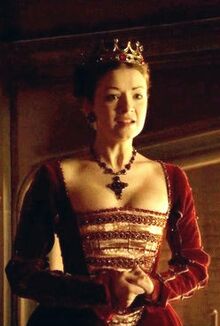
Mary claims she will "burn as many heretics as it takes" if she becomes Queen, foreshadowing her reign as a fanatical Catholic
Although it is not shown on the series, Mary became Queen on July 19, 1553. She eventually was to marry Philip of Spain in 1554 although they had no children, and ruled for five years, becoming the fourth Tudor monarch. Mary is remembered for restoring Roman Catholicism to England, and enforcing it by brutally burning hundreds of Protestants, earning her the moniker "Bloody Mary". While Mary actually improved England's economy considerably—which was damaged after her father's decades of extravagance and costly military campaigns—her ruthless religious policies quickly made her unpopular (even causing several Protestant revolts), and actually strengthened the Protestant cause in England; her attempts to return England to Catholicism were reversed after her death by her half-sister and successor, Elizabeth Tudor. Mary died in 1558, reluctantly recognizing Elizabeth as her heir. Despite being seen by the majority of England as Henry's most rightful heir after her brother Edward, Mary's reign was the shortest of Henry's three children and had the least lasting effect. Her marriage to her ambitious Spanish husband also saw England grow more subservient to its rival Spain, a status that Elizabeth helped counter.
Personality
Unlike her two younger half-siblings, Mary knew her mother for a substantial amount of time; Elizabeth's was executed when she was nearly three and Edward's died days after his birth. Being raised by her loving, wise, and passionately Catholic mother, Catherine of Aragon, had a distinct effect on Mary's personality. Mary is a shrewd, attractive and usually kind young woman who shows deference to almost no-one except her parents; she is extremely grounded and has admirable determination. But her views are distorted by her extremist Catholic faith, which makes her consider Protestantism complete heresy with no compromise. This, combined with a ruthless streak that she definitely got from her father, makes her a formidable character, although her short reign as queen had mixed results at the very best. She becomes increasingly unbending as the series goes on, embittered by her encounters with Anne Boleyn and Katherine Howard, as well as her various unsuccessful attempts to marry and have children. Nonetheless, in spite of his mistreatment of her in Season Two, Mary's love and loyalty to her father remains intact.
Mary's stepmothers and siblings
Mary's reactions to her various stepmothers are mixed; she never lost her loyalty and love for her mother, Catherine of Aragon, and since Anne Boleyn was the one who usurped them from court, this is primarily why she hates her, despite Anne's initial attempts to make peace with her. Otherwise, she would probably have liked Anne's unique style, boldness and intelligence—if Anne had not also been a Protestant. As it was, Mary continued to refer to her as the king's mistress or as a harlot, refusing an offer to restore her to the court if she acknowledged Anne as Queen. Anne did not push the issue, but she wisely kept Mary at an arm's length from her mother and made sure Henry kept her off the line of succession, as well as making her a lady-in-waiting to Mary's newborn sister. Meanwhile, Anne's cruel remarks about Catherine only made Mary more hateful towards her. Mary reacted to Anne's execution with as much satisfaction as Anne had at her mother's death.
Her relationship with Jane Seymour was quite different; Seymour was anxious that Mary be treated well and restored to the royal line, and as she was Henry's favorite queen, Mary's influence with her father improved despite the fact that Jane's unborn son would pass Mary to the throne. Jane also shared Mary's strong Catholic faith, unlike the Protestant Boleyn. Mary had very friendly relationship with her second stepmother, but unfortunately Jane died not long after giving birth to her half-brother Edward; Mary wept at her funeral procession.
When Henry later married, then rejected, Anne of Cleves, despite Anne's Lutheran background, Mary also found mutual respect and friendship with her, as both were dignified, intelligent dowagers. However, her attitude towards the King's fifth Queen, Katherine Howard (who was several years Mary's junior) was entirely different despite Katherine being (in name, if nothing else) a Catholic. Mary was extremely contemptuous of Katherine's stupidity, vanity and vast sexual appetite, and despised her as much as she had Anne Boleyn. She also resented Katherine because she saw her as the usurper of Anne of Cleves, as Anne Boleyn had been to her mother. When Mary degraded Katherine on her failure to produce children, Katherine retorted that Mary would never manage to marry or have children, which reduced Mary to tears until Chapuys came and comforted her. The day that Katherine was executed, Mary once again showed a savage satisfaction.
Catherine Parr, the final Queen of Henry VIII, also had a good relationship with Mary since she was an intelligent and dignified woman who was closer to Henry's age, and did everything she could do be a loving stepmother to all three of her stepchildren. In fact, she was instrumental to their fostering a closer relationship with their father. However, Mary later became suspicious of Catherine's role in Edward's and Elizabeth's education, and correctly assumed that her younger siblings were being influenced in favour of Protestantism and were, in her eyes, heading for damnation. Hence, she withdrew her favour from Catherine, though she later accepted her comforting when her father bid her a final farewell.
Despite her hatred of Anne Boleyn, Mary did not show any initial hatred for her half-sister, Elizabeth (who was mothered by Anne), whom she was forced to care for as an infant. In fact, she gave Elizabeth nothing but affection, and though she was pleased when Elizabeth was removed from the line of succession, she continued to act as a kind and loving older sister towards her. She and Queen Jane also helped her to be reintroduced to court and restored to their father's favour. The two sisters were even shown to share the same bed, and a teenage Elizabeth trusted Mary enough to confide in her older sister about her pity for Katherine Howard, and her determination to never marry because of it, and though she did not voice it, it was evident that Mary disagreed with Elizabeth's opinions.
However, as adults, their relationship soured: Mary became paranoid of her sister as a potential usurper, just as Anne Boleyn was of her, and their different religious beliefs (Mary was a fanatical Catholic while Elizabeth was a tolerant Protestant) drove them further apart. Once Mary had secured the crown, she later had her sister placed in the Tower of London when it was apparent that their dramatic differences and Elizabeth's increasing popularity with the people meant that the two sisters could no longer be in harmony, and threatened her with execution, but this sentence was later reduced to house arrest due to lack of substantial evidence as to Elizabeth's involvement in the increasing plots and rebellions to have Mary disposed. When her marriage produced no children, Mary was forced to restore Elizabeth as her heir apparent on her deathbed.
By contrast, Mary always saw her younger half-brother, Edward, as the legitimate heir despite her own claim to the throne. She was shown to have always treated him affectionately, even spending an entire night by the altar in tearful prayer to God for help when she learned that he was dangerously ill. However, their relationship was not as intimate as that between him and Elizabeth, and when he took the throne, their relationship soured drastically due to their different religious beliefs (Edward was as much of a fanatical Protestant as Mary was a fanatical Catholic). Edward was said to have reduced Mary to tears during a court gathering where the three siblings united after their father's death—an extremely rare moment—due to a heated argument in religion. When he was on his deathbed, he disinherited Mary for fear that she would bring England back to Catholicism, and named Lady Jane Grey his heir, though this did not stop Mary from ultimately becoming Queen Mary I of England.
Relationships:
Mary was betrothed at least three times before she was twelve years old: to the Dauphin Henri-Philippe, to her cousin Charles V, Holy Roman Emperor and King of Spain, and to the Duke of Orleans. However, none of these betrothals was followed through.
As she grew older Mary's devotion to Catholicism was well-known, even internationally, leading Chapuys to remark ironically to King Henry that anyone who tried to court her would have to treat her "like a nun". However, being Mary's dearest friend and the ambassador of her cousin, Chapuys nonetheless put forward several candidates for Mary's hand to Henry; these potential marriages would not have made her Queen, but they would have brought her back into contact with her mother's family in Catholic Spain and given her a very comfortable lifestyle.
Mary herself occasionally seemed wistful over her lack of marriage (and broke down into tears after being taunted about this by Katherine Howard) but was usually resigned to her single life. There are only two occasions, both in Season Three, where she showed any real interest in a romantic relationship and marriage. The first was to Don Luis, Charles' nephew and first Admiral; Mary was definitely intrigued when Chapuys described his accomplishments, faith and good looks. However, the match was delayed and ultimately discarded due to heightening tensions between King Henry and Emperor Charles.
Mary's second real attempt at betrothal came from her new stepmother Anne of Cleves, who proposed her handsome and charming cousin Philip, Duke of Bavaria- a match that could have elevated her into the German nobility. Mary initially reacted to this option with hostility (because Anne and Philip were both from Lutheran states) but on meeting Philip in person she was quickly charmed by him. Overhearing him express his admiration for both her and her mother Catherine, she quickly fell for Philip, culminating in a passionate kiss after dancing with him at court. However, shortly afterwards her father's alliance with the Protestant League failed, resulting in Philip being sent back to Germany; while she calmly admitted to Anne that she could not have married Philip anyway due to their religious differences, Mary was privately heartbroken. Had she married Philip, she might not have held onto her faith with such fanaticism.
Ultimately, during her reign as Queen she was married to King Philip II of Spain (the son of her cousin Charles) but the marriage was extremely unpopular, one-sided (Philip held no love for Mary and seldom even visited her) and produced no children.
Quotes
- "I know of no Queen of England but my mother. And I will accept no Queen but my mother."
- To Anne Boleyn: "I recognize no Queen but my mother... but, if the King's mistress would intercede with him on my behalf, then I would be grateful." (Anne pauses, then jerks her chin at Mary, indicating for her to leave)
- "Is the harlot dead?"
- "I'm not my mother's daughter?"
- "I am afraid I was not born for happiness."
- "Lady, you must know how beloved you are to the people—as was your mother before you, God rest her soul." — Robert Aske to Mary.

